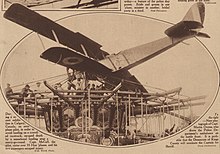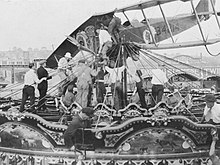Frederick McCall
Frederick McCall | |
|---|---|
No. XIII Squadron RAF No. 41 Squadron RAF | |
| Battles/wars | World War I World War II |
| Awards | Distinguished Service Order Military Cross & Bar Distinguished Flying Cross |
| Other work | Aviation pioneer |
Frederick Robert Gordon McCall
Early life
Born in
McCall expressed interest in transferring from the army to the
Aerial service in World War I
McCall's first aerial victory occurred while flying the
After his third victory while flying the R.E.8, McCall was next transferred to
On 17 August, he was accompanying William Gordon Claxton when the pair of them ran into Jagstaffel 20, which consisted of at least 40 aircraft. In the ensuing fight, which saw Claxton shot down, McCall scored a victory.
McCall was ordered to England, and eventually to Canada, on convalescent leave. The
Life between the wars


Following the armistice, McCall embarked upon a variety of civil aviation ventures, beginning with stunt flying. On 5 July 1919, while barnstorming, he crash-landed when his engine failed while he was taking off. His landing site was the top of the merry-go-round at the
He founded his own company, McCall Aero Corporation Limited, in 1920. With this company, McCall flew commercial freight and passengers across Canada, pioneering air travel to Banff.
In 1928, he founded, with Emil Sick, another aviation company Great Western Airways.[7] One of his more spectacular achievements was the flying of 200 quarts of nitroglycerin from Shelby, Montana to Calgary in 1928.
The following year, he ignored bad weather to fly a doctor to the Skiff oil fields to treat two seriously injured workers.
McCall also worked to encourage the formation of Canadian flying clubs in the inter-war years.
World War II and beyond
With the arrival of the
McCall died in Calgary Alberta on 22 January 1949 at the age of 52.

In the city of
References
- ^ The Aerodrome 2019.
- ^ Shores 2001, p. 74.
- ^ Alberta Online Encyclopedia 2019.
- ^ Mapplebeck 2019.
- ^ Franks 2007.
- ^ Logan 2019.
- ^ "Great Western Airways". AirlineHistory.co.uk. Airline History. Retrieved 7 February 2020.
- Additional sources
- "WWI Aces of Canada: Frederick McCall". TheAerodrome.com. The Aerodrome. 2019. Retrieved 3 August 2019.
- "Fred McCall – Alberta Online Encyclopedia". ABHeritage.ca. Heritage Community Foundation. 2019. Archived from the original on 8 December 2010. Retrieved 3 August 2019.
- ISBN 9781846031809. - Total pages: 96
- Logan, Shawn (2 July 2019). "How a flying ace crash landed on a Calgary Stampede carousel". Edmonton Sun. Retrieved 3 August 2019.
- Mapplebeck, D. L. (21 January 2019). "Fred McCall". TheHangarMuseum.ca. The Hanger Museum. Retrieved 3 August 2019.
- Shores, Christopher (2001). British and Empire Aces of World War 1. ISBN 9781841763774. - Total pages: 96
